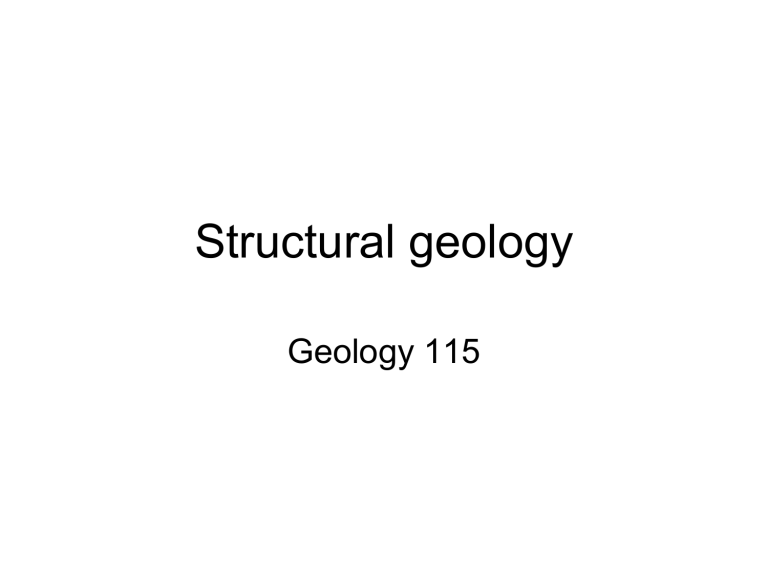Structural geology Geology 115

Structural geology
Geology 115
Structural geology
• The study of the deformation and fabric of rocks in order to understand the tectonic forces
• Rheology is the study of the effect of stress on materials
Stress-strain diagram
• Stress is measured as a force applied to a material
• Strain is the resulting change in volume of the material
• Elastic means that the material returns to its normal volume once the stress is removed; plastic (or ductile ) means that it does not
Earth ’ s interior structure
• In fact, using seismic studies, we can measure the depth at which the
Earth ’ s materials reach the elastic/ductile point
• This is where the material becomes
“ gooey ”
The stress-strain diagram is misleading
• It shows only one type of tectonic stress -compression
• Two other types -extension and shearing
“ Classic ” plate tectonic settings and mountain building
• Divergent boundary – fault-block mountains (horsts and grabens)
Extensional stress
• Normal faults arise from extensional stress
• Called “ normal ” because of age relationship of rocks across the fault
• Detachment faults are low-angle normal faults
Orogeny - horst and graben
“ Classic ” plate tectonic settings and mountain building
• Divergent boundary – fault-block mountains (horsts and grabens)
• Collision (convergent) boundary – “ foldand-thrust ” belts
“ Classic ” plate tectonic settings and mountain building
• Divergent boundary – fault-block mountains (horsts and grabens)
• Collision (convergent) boundary – “ foldand-thrust ” belts
• Subduction (convergent) boundary – volcanic arc mountains
Compression leads to certain structures
• Specifically, ductile structures called folds
• Sedimentary rocks can be deformed this way, but some metamorphism may also occur
Rock fabric
Terms associated with folds
Plunging folds
• Because the whole fold may be tilted perpendicular to the axial plane, folds may plunge
• The plunge is measured as an orientation and an angle off of horizontal
But even the toughest rocks break, and the break is called a fault
Faults
• Faults are a break in a rock along which offset has clearly occurred
• Breaks where there is no evidence of motion are called joints
• All types of tectonic stress may lead to faults
Compressive stress
• Reverse faults result from compression
• Called “ reverse ” because of age relationship of rocks across the fault
• Thrust faults are reverse faults with a fault dip angle <
45 °
Orogeny - fold and thrust belt
“ Classic ” plate tectonic settings and mountain building
• Divergent boundary – fault-block mountains (horsts and grabens)
• Collision (convergent) boundary – “ foldand-thrust ” belts
• Subduction (convergent) boundary – volcanic arc mountains
• Transform boundaries are not associated with mountain-building
Shearing stress
• Strike-slip faults result from shearing stress
• Called “ strike-slip ” because motion is along strike (horizontal orientation)
• Types: left-lateral, right-lateral
Orogeny - transpressional
• Mountain building occurs in strike-slip fault areas with some compression
• Called “ obliqueslip ”
Origin of the Transverse
Ranges
“ Transpressional ”
Origin of the Sierra Nevada
Relict subduction zone
Gettysburg NMP
(1895) in 1863
All of the folding in the
Gettysburg area is due to the collision of African and
North American plates and the closing of the Iapetus
Ocean 325 – 280 million years ago
“Thin-skinned” tectonics = fold-and-thrust belt = a region where there has been a shortening of the crust due to tectonic compression , and a series of folds and thrust faults have been created, with the thrust faults all connecting at a relatively shallow depth at a décollement
Gettysburg basin, and other basins aligned with it, developed as a result of the rifting of the supercontinent
Pangaea and the opening of the
Atlantic Ocean about
220 mya
Chickamauga and Chattanooga NMP (1890)
Moccasin Bend
Railro
Long linear ridges
Digital elevation model of eastern Tennessee – note the eroded anticline and the thrust faults







